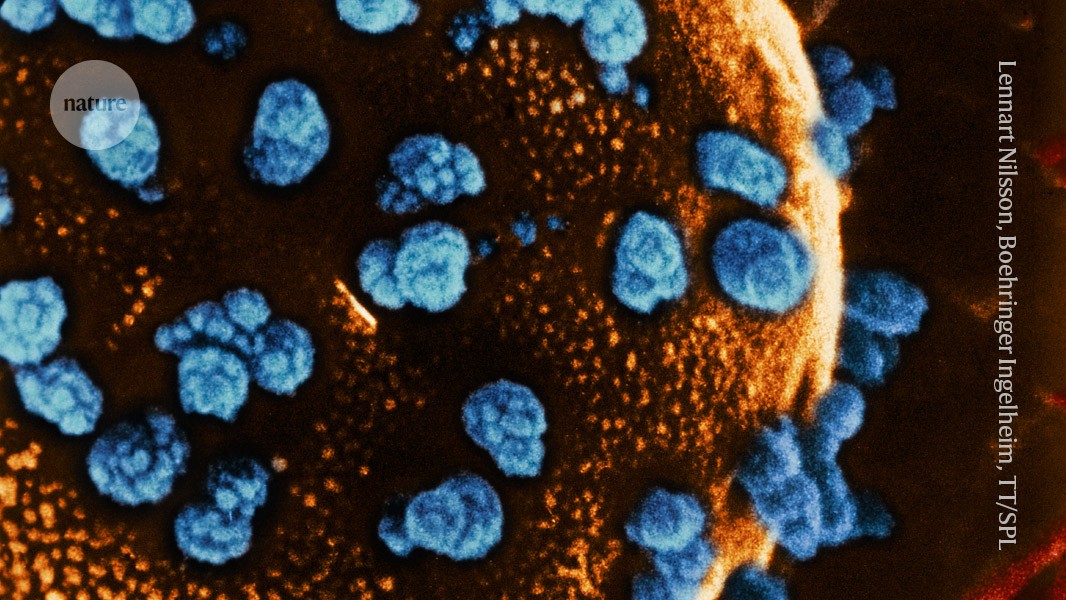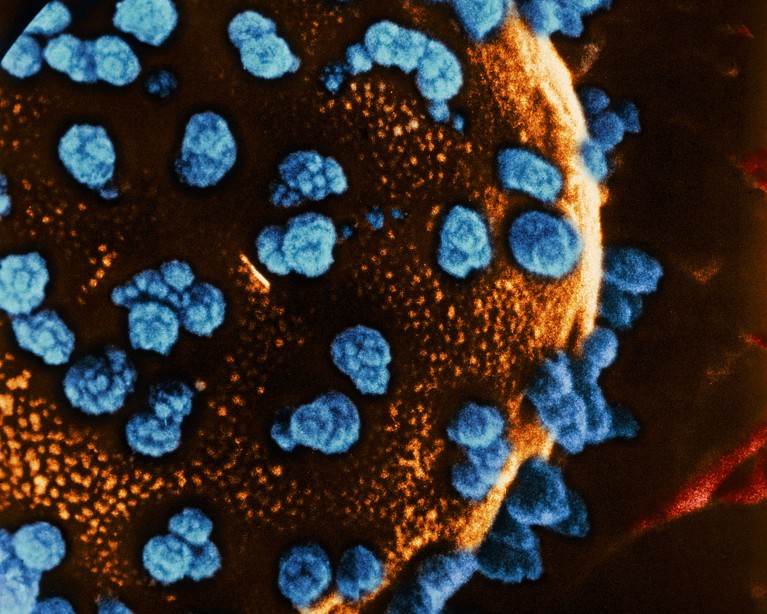
Stem cells reverse woman’s diabetes — a world first
She is the first person with type 1 diabetes to receive this kind of transplant.
26 September 2024
Stem cells reverse woman’s diabetes — a world first
She is the first person with type 1 diabetes to receive this kind of transplant.
Smriti Mallapaty
- Email

A woman with type 1 diabetes started producing insulin (blue) after a stem cell transplant.Credit: Lennart Nilsson, Boehringer Ingelheim International GmbH, TT/Science Photo Library
A 25-year-old woman with type 1 diabetes started producing her own insulin less than three months after receiving a transplant of reprogrammed stem cells<a href="Stem cells reverse woman’s diabetes — a world first" data-track="click" data-action="anchor-link" data-track-label="go to reference" data-track-category="references">1</a>. She is the first person with the disease to be treated using cells that were extracted from her own body.
“I can eat sugar now,” said the woman, who lives in Tianjing, on a call with Nature. It has been more than a year since the transplant, and, she says, “I enjoy eating everything — especially hotpot.” The woman asked to remain anonymous to protect her privacy.
James Shapiro, a transplant surgeon and researcher at the University of Alberta in Edmonton, Canada, says the results of the surgery are stunning. “They’ve completely reversed diabetes in the patient, who was requiring substantial amounts of insulin beforehand.”
The study, published in Cell today, follows results from a separate group in Shanghai, China, who reported in April that they had successfully transplanted insulin-producing islets into the liver of a 59-year-old man with type 2 diabetes<a href="Stem cells reverse woman’s diabetes — a world first" data-track="click" data-action="anchor-link" data-track-label="go to reference" data-track-category="references">2</a>. The islets were also derived from reprogrammed stem cells taken from the man’s own body and he has since stopped taking insulin.
The studies are among a handful of pioneering trials using stem cells to treat diabetes, which affects close to half a billion people worldwide. Most of them have type 2 diabetes, in which the body doesn’t produce enough insulin or its ability to use the hormone diminishes. In type 1 diabetes, the immune system attacks islet cells in the pancreas.
Islet transplants can treat the disease, but there aren’t enough donors to meet the growing demand, and recipients must use immune-suppressing drugs to prevent the body from rejecting the donor tissue.
Stem cells can be used to grow any tissue in the body and can be cultured indefinitely in the laboratory, which means they potentially offer a limitless source of pancreatic tissue. By using tissue made from a person’s own cells, researchers also hope to avoid the need for immunosuppressants.
Reprogrammed cells
In the first trial of its kind, Deng Hongkui, a cell biologist at Peking University in Beijing, and his colleagues extracted cells from three people with type 1 diabetes and reverted them into a pluripotent state, from which they could be moulded into any cell type in the body. This reprogramming technique was first developed by Shinya Yamanaka at Kyoto University in Japan almost two decades ago. But Deng and his colleagues modified the technique<a href="Stem cells reverse woman’s diabetes — a world first" data-track="click" data-action="anchor-link" data-track-label="go to reference" data-track-category="references">3</a>: instead of introducing proteins that trigger gene expression, as Yamanaka had done, they exposed the cells to small molecules. This offered more control over the process.
The researchers then used the chemically induced pluripotent stem (iPS) cells to generate 3D clusters of islets. They tested the safety and efficacy of the cells in mice and non-human primates.
In June 2023, in an operation that lasted less than half an hour, they injected the equivalent of roughly 1.5 million islets into the woman’s abdominal muscles — a new site for islet transplants. Most islet transplants are injected into the liver, where the cells cannot be observed. But by placing them in the abdomen, the researchers could monitor the cells using magnetic resonance imaging, and potentially remove them if needed.
Insulin free
Two-and-a-half months later, the woman was producing enough insulin to live without needing top-ups, and she has sustained that level of production for more than a year. By that time, the woman had stopped experiencing the dangerous spikes and drops in blood glucose levels, which remained within a target range for more than 98% of the day. “That’s remarkable,” says Daisuke Yabe, a diabetes researcher at Kyoto University. “If this is applicable to other patients, it’s going to be wonderful.”
The results are intriguing, but they need to be replicated in more people, says Jay Skyler, an endocrinologist at the University of Miami, Florida, who studies type 1 diabetes. Skyler also wants to see that the woman’s cells continue to produce insulin for up to five years, before considering her ‘cured’.
Deng says the results for the other two participants are “also very positive”, and they will reach the one-year mark in November, after which he hopes to expand the trial to another 10 or 20 individuals.
Because the woman was already receiving immunosuppressants for a previous liver transplant, the researchers could not assess whether the iPS cells reduced the risk of rejection of the graft.
Even if the body doesn’t reject the transplant because it doesn’t consider the cells to be ‘foreign’, in people with type 1 diabetes, because they have an autoimmune condition, there is still a risk that the body could attack the islets. Deng says they didn’t see this in the woman because of the immunosuppressants, but they are trying to develop cells that can evade this autoimmune response.
Donor cells
Transplants using the recipient’s own cells have advantages, but the procedures are difficult to scale up and commercialize, say researchers. Several groups have started trials of islet cells created using donor stem cells.
Preliminary results for one trial, led by Vertex Pharmaceuticals in Boston, Massachusetts, were reported in June. A dozen participants with type 1 diabetes received islets derived from donated embryonic stem cells that were injected into the liver. They were all treated with immunosuppressants. Three months after the transplant, all the participants began producing insulin when glucose was present in their bloodstreams<a href="Stem cells reverse woman’s diabetes — a world first" data-track="click" data-action="anchor-link" data-track-label="go to reference" data-track-category="references">4</a>. Some had become insulin independent.
Last year, Vertex launched another trial in which islet cells derived from donated stem cells were placed in a device designed to protect them from immune-system attacks. It was transplanted into a person with type 1 diabetes, who did not receive immunosuppressants. “That trial is ongoing,” says Shapiro, who is involved in the study, which aims to enrol 17 individuals.
Yabe is also about to start a trial using islet cells produced using donor iPS cells. He plans to develop sheets of islets and surgically place them in the abdominal tissue of three people with type 1 diabetes, who will receive immunosuppressants. The first participant should receive their transplant early next year.
doi: Stem cells reverse woman’s diabetes — a world first
 Amazing stuff.
Amazing stuff.